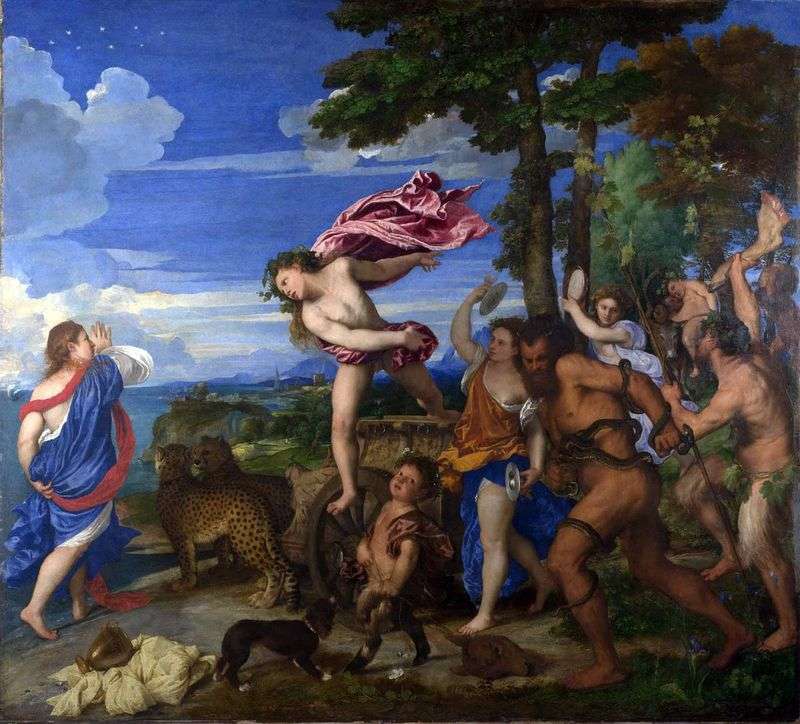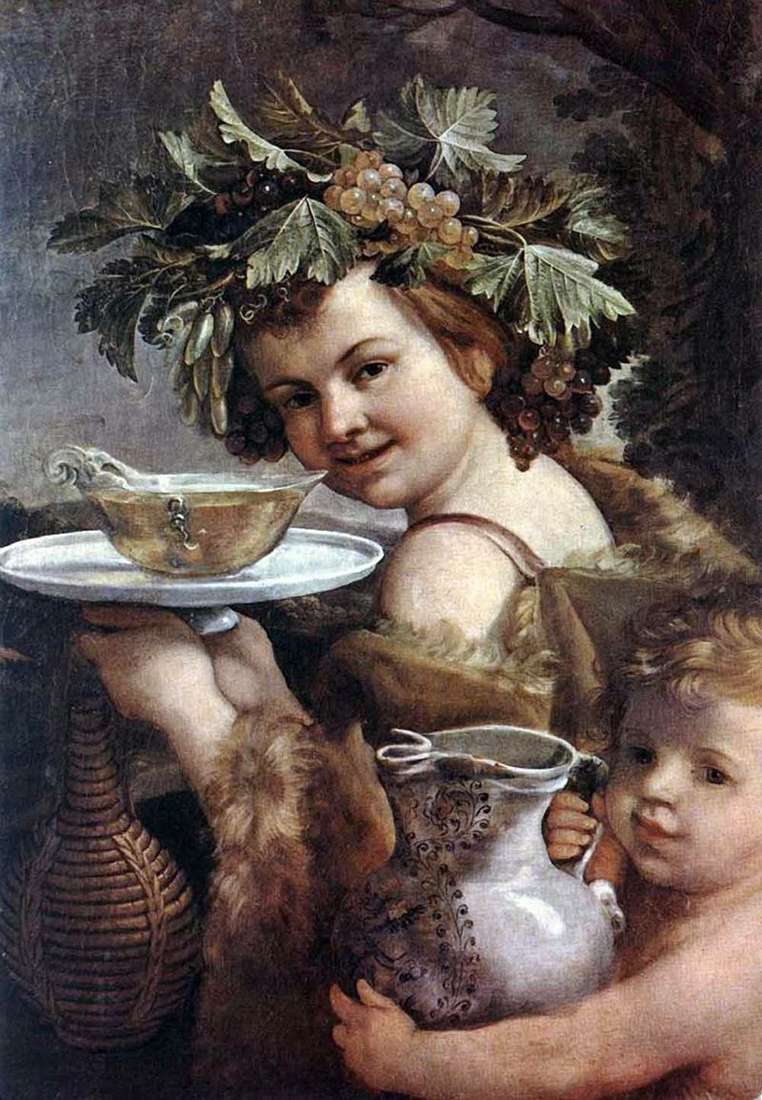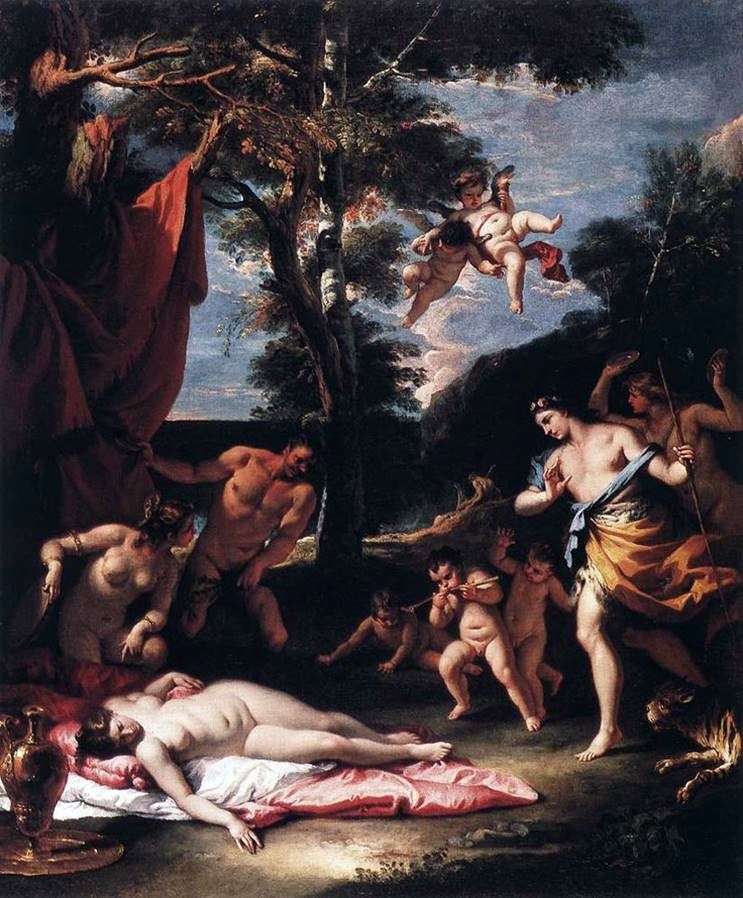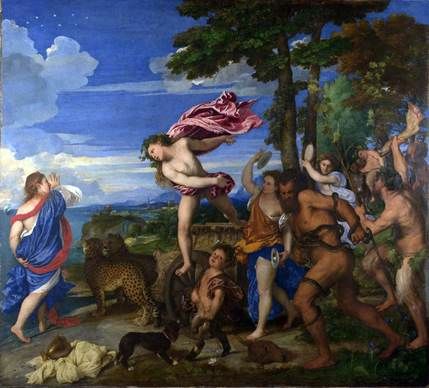
1520-1522. National Gallery, London. The painting of the artist Tiziano Vecellio “Bacchus and Ariadne”.
Dionysus in Greek mythology – the god eternally young fruit-bearing forces of the earth, vegetation, wine growing and wine-making, known as the “god with bull’s horns”, because he loved to take the form of a powerful animal, the son of Zeus and the Theban princess Semele. Zeus, who appeared before the princess in a lightning flash, accidentally incinerated his mortal lover, but managed to snatch the flame from a premature Dionysus and sewed it into his thigh. In due time God has given birth to a child and the education nymphs.
Grew up, Dionysus, wandering on a candle, Theseus abandoned Ariadne met and married a drink. Dionysus was known as God frees people from worries and take off the fetters of a measured life, so Dionysus procession bore ecstatic character; it was attended by satyrs, maenads and Bacchantes. Belted snakes, they are crushing on its way and praised Dionysus, drinking the blood of torn wildlife and pulling the crowd of cheering people. In ancient Rome, Dionysus was worshiped under the name of Bacchus.
Ariadne – daughter of Cretan King Minos and his wife Pasiphae. Nor any supernatural intervention in the process. She lived in the palace of Knossos in Crete, danced himself on the stage, which is specially designed for her Daedalus, and, in fact, happy. But Theseus came to the island, won her heart on sports games, and she lost her head, forgetting all about his father and mother, and even a great power interests.
Power here and here. Theseus arrived on the island to kill the monster Minotaur, cannibal with a human body and a bull’s head. Athens, where Theseus arrived, carrying a terrible toll – seven boys and seven girls have were once in seven years to give to be devoured by the monster. Here, Theseus volunteered to relieve the country from the yoke.
Ariadne promised to help her lover if he would take her as his wife – and helped. The Minotaur lived in the labyrinth, and it was not enough to kill him, then it was necessary to also get out of the tangle of corridors, passages and stairs. Firstly, Ariadne gave Theseus the thread unwinding which is on the road, he could always was sure that he would find a way back. This sensible thoughts suggested the girl, of course, the ingenious Daedalus. And secondly, she gave the boy a crown shining in the darkness.
So, Theseus Minotaur killed Ariadne on the ship – and soon to go home! But on the way off the island of Naxos ship caught a terrible storm, the sailors were forced to hit the beach. But Theseus had a dream the night – they say, is another Ariadne, namely Dionysus. Perhaps Theseus is invented to justify the morning until Ariadne was still asleep, he quickly gathered little things, called satellites, and was gone. Girl wakes up – and instead of a lover – if you please! – Next to an old friend, Dionysus! I believe it is here between them there was a scandal, in which Dionysus threw the sky ariadnovu crown. Anyway, God persuaded the princess, and she did marry him out.
Heroic optimism inherent in Titian’s work after the 1516-1518 years, apparently due to the general rise in the spiritual and social life of Venice, caused by a sense of the vital resistance of the city, manifested during the struggle with the League of Cambrai and the ensuing war, the so-called Holy League. There is no longer “dzhordzhonevskoy silence” and his “orgy”, and in particular in the painting “Bacchus and Ariadne”.
This picture is perceived as excited hymn to the beauty and power of the human sense of asserting themselves. The composition of the picture whole and free from the distractions of minor scenes and details. Joyful joyous Bacchus wide and free gesture refers to Ariadne. Hot color, beauty rushing, excited landscape, in tune with the mood, typical for this picture.
 Bacchus and Ariadne by Titian Vecellio
Bacchus and Ariadne by Titian Vecellio Triumph of Bacchus and Ariadne by Annibale Carracci
Triumph of Bacchus and Ariadne by Annibale Carracci Bacchus and Ariadne (Bacchanalia) by Nicolas Poussin
Bacchus and Ariadne (Bacchanalia) by Nicolas Poussin Junior Bacchus by Guido Reni
Junior Bacchus by Guido Reni Mercury hands the nymphs of the infant Bacchus by Francois Boucher
Mercury hands the nymphs of the infant Bacchus by Francois Boucher Meeting of Bacchus and Ariadne by Sebastiano Ricci
Meeting of Bacchus and Ariadne by Sebastiano Ricci The Festival of Venus (Bacchanalia of Babies) by Titian Vecellio
The Festival of Venus (Bacchanalia of Babies) by Titian Vecellio Bacchus et Ariane – Titian Vecellio
Bacchus et Ariane – Titian Vecellio